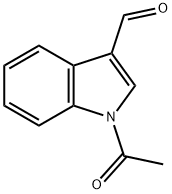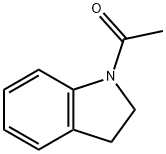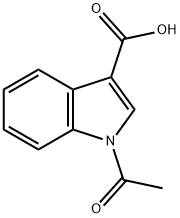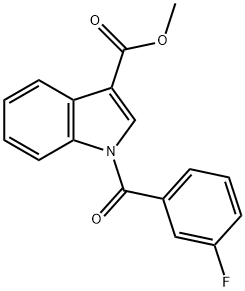N-ACETYLINDOLE-3-CARBOXALDEHYDE
Synonym(s):N-Acetylindol-3-carboxaldehyde;NSC 61289
- CAS NO.:22948-94-3
- Empirical Formula: C11H9NO2
- Molecular Weight: 187.19
- MDL number: MFCD00039691
- EINECS: 245-347-0
- SAFETY DATA SHEET (SDS)
- Update Date: 2023-05-04 17:34:36

What is N-ACETYLINDOLE-3-CARBOXALDEHYDE?
Chemical properties
White to yellow crystalline powder
The Uses of N-ACETYLINDOLE-3-CARBOXALDEHYDE
Reactant for synthesis of α-ketoamides as inhibitors of Dengue virus protease with antiviral activity in cell-culture
Reactant for preparation of homoallylic amines as antimicrobial agents
Reactant for preparation of pyrrole-based hydrazones as potential tuberculostatics
Reactant for synthesis of neoechinulin A and derivatives
Reactant for synthesis of substituted (Z)-2-(N-benzylindol-3-ylmethylene)quinuclidin-3-one and (Z)-(±)-2-(N-benzylindol-3-ylmethylene)quinuclidin-3-ol derivatives as potent thermal sensitizing agents
Reactant for preparation of RNA-specific live cell imaging probes E36, E144 and F22
Definition
ChEBI: 1-acetylindole-3-carboxaldehyde is an N-acylindole that is N-acetylindole carrying an additional formyl substituent at position 3. It has a role as a plant metabolite. It is a N-acylindole and an arenecarbaldehyde.
General Description
1-Acetyl-3-indolecarboxaldehyde participates in the preparation and characterization of three RNA-specific fluorescent probes (E36, E144 and F22), useful in live cell imaging.
Properties of N-ACETYLINDOLE-3-CARBOXALDEHYDE
| Melting point: | 165 °C(lit.) |
| Boiling point: | 336.0±15.0 °C(Predicted) |
| Density | 1.19±0.1 g/cm3(Predicted) |
| storage temp. | 2-8°C |
| Sensitive | Air Sensitive |
| CAS DataBase Reference | 22948-94-3(CAS DataBase Reference) |
Safety information for N-ACETYLINDOLE-3-CARBOXALDEHYDE
| Signal word | Warning |
| Pictogram(s) |
 Exclamation Mark Irritant GHS07 |
| GHS Hazard Statements |
H315:Skin corrosion/irritation H319:Serious eye damage/eye irritation H335:Specific target organ toxicity, single exposure;Respiratory tract irritation |
| Precautionary Statement Codes |
P261:Avoid breathing dust/fume/gas/mist/vapours/spray. P264:Wash hands thoroughly after handling. P264:Wash skin thouroughly after handling. P271:Use only outdoors or in a well-ventilated area. P280:Wear protective gloves/protective clothing/eye protection/face protection. P302+P352:IF ON SKIN: wash with plenty of soap and water. P305+P351+P338:IF IN EYES: Rinse cautiously with water for several minutes. Remove contact lenses, if present and easy to do. Continuerinsing. |
Computed Descriptors for N-ACETYLINDOLE-3-CARBOXALDEHYDE
New Products
Tert-butyl bis(2-chloroethyl)carbamate 4-Methylphenylacetic acid N-Boc-D-alaninol N-BOC-D/L-ALANINOL 3-Morpholino-1-(4-nitrophenyl)-5,6-dihydropyridin- 2(1H)-one Furan-2,5-Dicarboxylic Acid Tropic acid 1,1’-CARBONYLDIIMIDAZOLE DIETHYL AMINOMALONATE HYDROCHLORIDE R-2-BENZYLOXY PROPIONIC ACID 1,1’-CARBONYLDI (1,2-4 TRIAZOLE) N-METHYL INDAZOLE-3-CARBOXYLIC ACID (2-Hydroxyphenyl)acetonitrile 4-Bromopyrazole 5-BROMO-2CYANO PYRIDINE 5,6-Dimethoxyindanone 5-broMo-2-chloro-N-cyclopentylpyriMidin-4-aMine 2-(Cyanocyclohexyl)acetic acid 4-methoxy-3,5-dinitropyridine 2-aminopropyl benzoate hydrochloride 1-(4-(aminomethyl)benzyl)urea hydrochloride diethyl 2-(2-((tertbutoxycarbonyl)amino) ethyl)malonate tert-butyl 4- (ureidomethyl)benzylcarbamate Ethyl-2-chloro((4-methoxyphenyl)hydrazono)acetateRelated products of tetrahydrofuran







![1-[1-(4-METHOXYBENZOYL)-1H-INDOL-3-YL]-1-ETHANONE](https://img.chemicalbook.in/StructureFile/ChemBookStructure7/GIF/CB3747904.gif)
You may like
-
 N-Acetylindole-3-carboxaldehyde 98% CAS 22948-94-3View Details
N-Acetylindole-3-carboxaldehyde 98% CAS 22948-94-3View Details
22948-94-3 -
 1-Acetyl-3-indolecarboxaldehyde CAS 22948-94-3View Details
1-Acetyl-3-indolecarboxaldehyde CAS 22948-94-3View Details
22948-94-3 -
 1975-50-4 98%View Details
1975-50-4 98%View Details
1975-50-4 -
 2-HYDROXY BENZYL ALCOHOL 98%View Details
2-HYDROXY BENZYL ALCOHOL 98%View Details
90-01-7 -
 2-Chloro-1,3-Bis(Dimethylamino)Trimethinium Hexafluorophosphate 221615-75-4 98%View Details
2-Chloro-1,3-Bis(Dimethylamino)Trimethinium Hexafluorophosphate 221615-75-4 98%View Details
221615-75-4 -
 14714-50-2 (2-Hydroxyphenyl)acetonitrile 98+View Details
14714-50-2 (2-Hydroxyphenyl)acetonitrile 98+View Details
14714-50-2 -
 118753-70-1 98+View Details
118753-70-1 98+View Details
118753-70-1 -
 733039-20-8 5-broMo-2-chloro-N-cyclopentylpyriMidin-4-aMine 98+View Details
733039-20-8 5-broMo-2-chloro-N-cyclopentylpyriMidin-4-aMine 98+View Details
733039-20-8